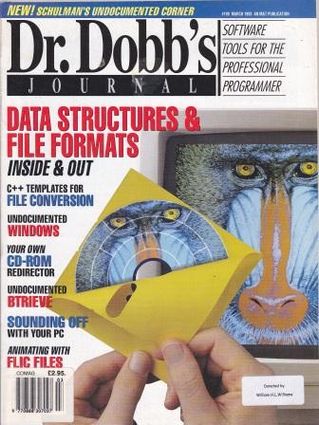
EDITORIAL
[author : Jonathan Erickson] #Edito
TABLE OF CONTENTS
FEATURES
THE FLIC FILE FORMAT
[author : Jim Kent]
As their name suggests, flic files are a sequence of still frames which can be rapidly flipped through to achieve the illusion of movement - the software equivalent of movies. Among the applications and tools that support the flic file format are the Autodesk's Animator, IBM's Ultimedia Tool Series, and Microsoft's Video for Windows.
FILE CONVERSION USING C++ TEMPLATES
[author : Timothy Butterfield]
Tim shows how C++ templates can be used to build parser-based "black box" conversion class that allows you to use various data types and processes without having to rewrite the basics of the conversion engine for each new combination.
COMPOUND DOCUMENTS
[author : Lowell Williams]
Compound documents contain a mixture of different data - text, line art, raster graphics (images), tabular data, and even audio and video. Lowell makes the case that the now-familiar ASCII can no longer fulfill its role as a universal document-interchange standard and that we should begin examining compound ASCII alternatives like ODL, SGML, and CDA.
DESIGNING COMPLEX DATACENTRIC APPLICATIONS
[author : Paul Bonneau]
Paul discusses the data structures and client/server architecture of HyperChem, a molecular modeling tool that runs on PCs and Silicon Graphics workstations. Implemented in about 500,000 lines of C code, HyperChem lets you create three-dimensional atomic structures, visualize and manipulate their structural relationships, and perform classical and semi-empirical, quantum mechanical calculations.
A DOS REDIRECTOR FOR SCSI CD-ROM
[author : Jim Harper]
Getting data from CD-ROM to where your application can use it isn't straightforward under MS-DOS. Jim examines how this process works under DOS, then presents the code for an MSCDEX-like extension to MS-DOS that allows access to either High Sierra or ISO-9660 CD-ROMs. This redirector works in conjunction with a TSR-based driver for SCSI devices.
JULIAN AND GREGORIAN CALENDARS
[author : Peter J.G. Meyer]
Peter presents a C function which converts any date within an 11-million-year period in either the Gregorian calendar or the Julian calendar into a unique number in the range of approximately -2,000,000,000 through 2,000,000,000.
EMBEDDED SYSTEMS
TOOLS FOR EMBEDDED-SYSTEMS DEBUGGING
[author : Christopher Perez]
Tools such as microprocessor in-circuit emulators, microprocessor on-chip debug circuitry, an logic analyzers can make the tough job of embedded-systems designers easier. Chris focuses on the JTAG specification and techniques for getting the most of logic analyzers.
NETWORKED SYSTEMS
INSIDE BTRIEVE FILES
[author : Douglas Reilly]
Knowing something about Btrieve's undocumented features can make the difference between success and failure when it comes to recovery of damaged Btrieve-compressed records.
EXAMINING ROOM
EXAMINING PC AUDIO
[author : John W. Ratclif]
There's a lot of noise being made about the need for software support for sound. John examines the options available to PC programmers, then presents a sound driver that produces high-quality digitized sound without requiring any extra hardware.
PROGRAMMER'S WORKBENCH
PROXY: A SCHEME-BASED PROTOTYPING LANGUAGE
[author : Burt Leavenworth]
Proxy, a Scheme-based interactive language with a C-like syntax, provides all the high-level data structures - sets, maps, sequences, and objects - useful for software design and prototyping. In addition to showing you how the language can be used in a typical prototyping session, Burt gives you the Proxy interpreter.
COLUMNS
PROGRAMMING PARADIGMS
[author : Michael Swaine]
The basic idea behind visual programming is , "What you see is what you'll make." Michael examines the this paradigm, using Serius's development tools for the Macintosh.
C PROGRAMMING
[author : Al Stevens]
More D-Flat++ control classes are presented this month, in particular those that provide support for pop-down menus, dialing boxes, radio and command buttons, the check box, and the base class for buttons.
STRUCTURED PROGRAMMING
[author : Jeff Duntemann]
Jeff looks at client/server database management and examines the APIs ranging from SQL to DLLs. He then speculates on what kind of database support Pascal vendors should begin thinking about.
UNDOCUMENTED CORNER
[author : Andrew Schulman]
In his inaugural column, Andrew presents Joe Newcomer and Bruce Horn's analysis of the undocumented RGNOBJ structure in Microsoft Windows. The region feature, which is maintained by the Windows GDI, is an arbitrarily-bounded area that can be used for filling, outlining, and clipping.
PROGRAMMER'S BOOKSHELF
[author : Ray Valdes]
Ray examines books that focus on artificial life: Artificial Life II, Emergent Computation, and John Holland's 1992 edition of Adoption on Natural and Artificial Systems.
FORUM
LETTERS
[author : you]
SWAINE'S FLAMES
[author : Michael Swaine]
PROGRAMMER'S SERVICES
OF INTEREST
[author : Tami Zemel]